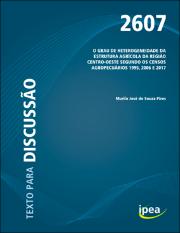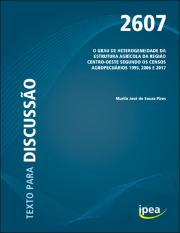Please use this identifier to cite or link to this item:
https://repositorio.ipea.gov.br/handle/11058/10304Full metadata record
| DC Field | Value | Language |
|---|---|---|
| dc.contributor.author | Pires, Murilo José de Souza | - |
| dc.coverage.spatial | Região Centro-oeste, Brasil | pt_BR |
| dc.coverage.temporal | 1995 | pt_BR |
| dc.coverage.temporal | 2006 | pt_BR |
| dc.coverage.temporal | 2017 | pt_BR |
| dc.date.accessioned | 2020-11-11T20:46:11Z | - |
| dc.date.available | 2020-11-11T20:46:11Z | - |
| dc.date.issued | 2020-10 | - |
| dc.identifier.uri | http://repositorio.ipea.gov.br/handle/11058/10304 | - |
| dc.description.abstract | É em meio ao processo de transformação das estruturas agropecuárias que surge a indagação central desta investigação, ou seja, como se encontra o grau de heterogeneidade do trabalho, no contexto da estrutura agrícola das Unidades da Federação (UFs), da região Centro-Oeste segundo os Censos Agropecuários 1995, 2006 e 2017? A ideia central dessa interrogação é testar e validar, empiricamente, as evidências teóricas apontadas pela Comissão Econômica para a América Latina e o Caribe (CEPAL) naquilo que se refere às estruturas produtivas de economias periféricas como a brasileira, as quais são marcadas por uma forte heterogeneidade produtiva. Adota-se o método histórico estrutural que tem por objetivo decompor, classificar, organizar, sistematizar e interpretar as informações contidas nas bases de dados da Secretaria de Comércio Exterior (Secex) do Ministério da Economia e nos dados dos Censos Agropecuários 1995, 2006 e 2017 do Instituto Brasileiro de Geografia e Estatística (IBGE). Por fim, nota-se que esse avanço da produtividade do trabalho agrícola entre as UFs aprofundou ainda mais o grau de heterogeneidade existente entre as economias modernizadas e aquelas ainda amarradas aos grilhões da agricultura tradicional e subsistência. No caso particular do Centro-Oeste, nota-se que Mato Grosso foi o estado que mais incrementou a sua produtividade do trabalho na agricultura, seguido por Mato Grosso do Sul, Goiás e, finalmente, pelo Distrito Federal. No entanto, é importante ressaltar que o grau de heterogeneidade da estrutura agropecuária municipal dos estados do Centro-Oeste apresentou um padrão entre os anos censitários. Em geral, entre os anos censitários de 1995, 2006 e 2017, o grau de heterogeneidade da estrutura agropecuária de Goiás foi maior vis-à-vis aos demais estados, ao mesmo tempo que Mato Grosso do Sul apresentou maior grau de homogeneidade em sua estrutura produtiva, dado o contexto regional. | pt_BR |
| dc.language.iso | pt-BR | pt_BR |
| dc.publisher | Instituto de Pesquisa Econômica Aplicada (Ipea) | pt_BR |
| dc.title | O Grau de heterogeneidade da estrutura agrícola da região Centro-Oeste segundo os Censos Agropecuários 1995, 2006 e 2017 | pt_BR |
| dc.title.alternative | Texto para Discussão (TD) 2607 : O Grau de heterogeneidade da estrutura agrícola da região Centro-Oeste segundo os Censos Agropecuários 1995, 2006 e 2017 | pt_BR |
| dc.type | Texto para Discussão (TD) | pt_BR |
| dc.rights.holder | Instituto de Pesquisa Econômica Aplicada (Ipea) | pt_BR |
| dc.source.urlsource | http://www.ipea.gov.br | pt_BR |
| dc.location.country | BR | pt_BR |
| dc.description.physical | 50 p. : il. | pt_BR |
| dc.subject.vcipea | IPEA::Agricultura::Economia Agrícola::Setor Agrícola – Geral::Estrutura Agrícola | pt_BR |
| dc.subject.vcipea | IPEA::Agricultura::Produção Agropecuária::Produção agropecuária::Censos Agropecuários | pt_BR |
| dc.rights.license | É permitida a reprodução deste texto e dos dados nele contidos, desde que citada a fonte. Reproduções para fins comerciais são proibidas. | pt_BR |
| dc.subject.keyword | Heterogeneidade estrutural | pt_BR |
| dc.subject.keyword | Produtividade do trabalho | pt_BR |
| dc.subject.keyword | Centro-Oeste | pt_BR |
| ipea.description.methodology | Método histórico estrutural | pt_BR |
| ipea.description.additionalinformation | Série monográfica: Texto para Discussão ; 2607 | pt_BR |
| ipea.description.additionalinformation | Possui referências bibliográficas; | pt_BR |
| ipea.access.type | Acesso Aberto | pt_BR |
| ipea.rights.type | Licença Comum | pt_BR |
| ipea.englishdescription.abstract | It is in the transformation process of agricultural structures that the central question of this investigation arises, that is, how is the degree of heterogeneity of work, in the context of the agricultural structure of the federation units, in the Midwest region according to the agricultural censuses of 1995, 2006 and 2017? The central idea of this question is to test and validate, empirically, the theoretical evidence pointed out by the Economic Commission for Latin America and the Caribbean (Eclac) in what refers to the productive structures of peripheral economies such as the Brazilian one, which are marked by a strong productive heterogeneity. The structural historical method is adopted, which aims to decompose, classify, organize, systematize and interpret the information contained in the databases of the Ministry of Economy’s Foreign Secretariat (Secex) and in the data from the 1995, 2006 and 2017 Agricultural Censuses of the Brazilian Institute of Geography and Statistics (IBGE). Finally, it is noted that this advance in the productivity of agricultural work among the units of the federation has further deepened the degree of heterogeneity that exists between modernized economies and those still tied to the fetters of traditional agriculture and subsistence. In the particular case of the Midwest, Mato Grosso was the state that most increased its labor productivity in agriculture, followed by Mato Grosso do Sul, Goiás and, finally, the Federal District. However, it is important to note that the degree of heterogeneity of the municipal agricultural structure in the states of the Midwest showed a pattern between the census years. In general, between the 1995, 2006 and 2017 census years, the degree of heterogeneity in the agricultural structure of the state of Goiás was greater vis-à-vis the other states, at the same time that the state of Mato Grosso do Sul presented a greater degree of homogeneity in its productive structure, given the regional context. | pt_BR |
| ipea.researchfields | N/A | pt_BR |
| ipea.classification | Agricultura, Pecuária e Pesca | pt_BR |
| Appears in Collections: | Agricultura, Pecuária e Pesca: Livros | |
Files in This Item:
| File | Description | Size | Format | |
|---|---|---|---|---|
| td_2607.pdf | 2.7 MB | Adobe PDF |  View/Open | |
| td_2607_sumex.pdf | 2.8 MB | Adobe PDF |  View/Open |
Items in DSpace are protected by copyright, with all rights reserved, unless otherwise indicated.

